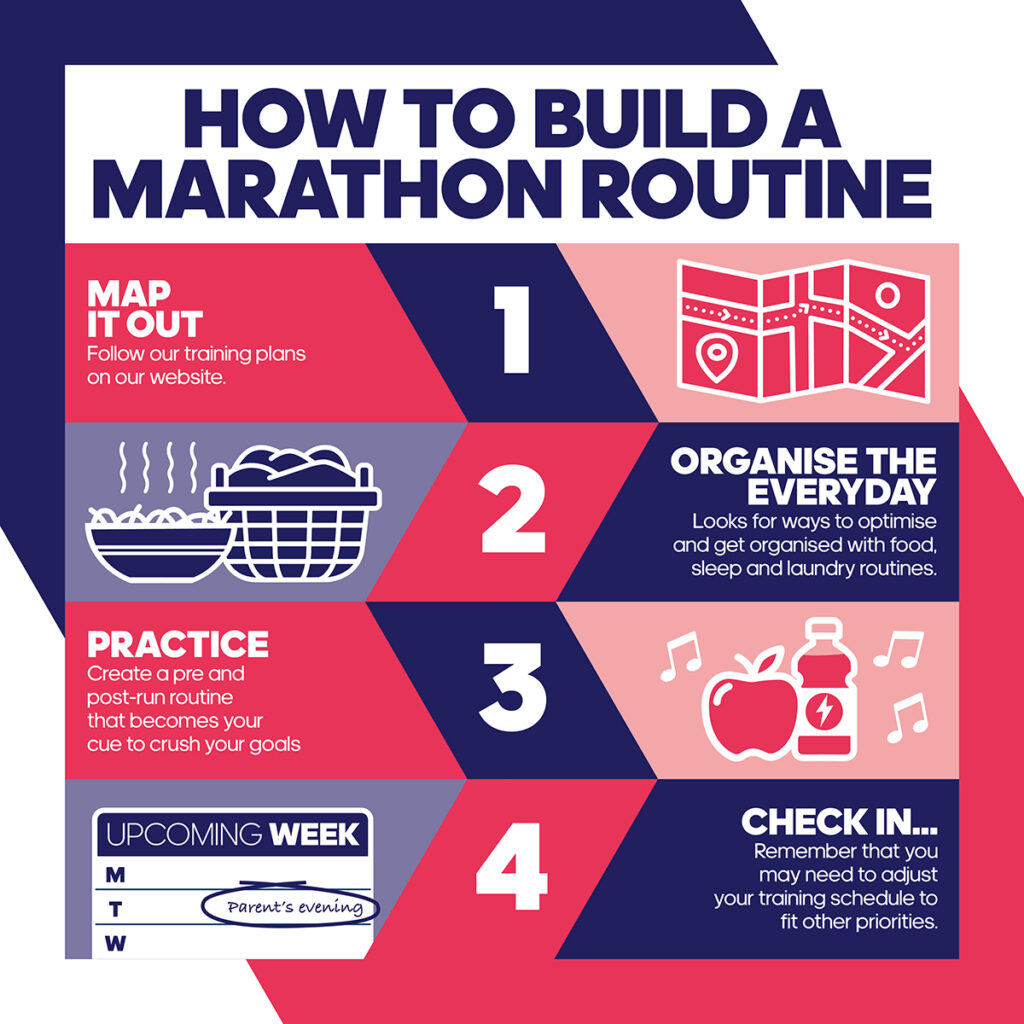How to Build Your Marathon Routine
Eat. Sleep. Train. Repeat. When it comes to preparing for a marathon, it’s true that routine is key. Sticking to a schedule allows you to not only crush your goals, but also eliminate stress which, let’s face it, everyone running a marathon could do without!
So, what does a consistent training routine look like, and how can you build one yourself? Follow these tips to build a bulletproof plan…

STEP ONE: MAP IT OUT
You should already have a ‘long-range’ training plan that takes you from a certain number of weeks to event day (Need help? Find the adidas and Best Athletics training plans here ). After this, it’s helpful to establish what this training looks like for you on a weekly basis. Ask yourself the following questions to create a consistent weekly plan:
1. Which days will you run on and at what time? Fix this into your calendar.
2. Where will your train? (if you like to switch this up each week, then plan this in advance).
3. What do I need to do ahead of time to be able to complete these sessions (e.g. if you run in the evening from the office, you will need to pack reflective clothing in the morning.).
By committing to these training days and making these actions habits, it won’t take long to settle into a consistent training routine which eliminates the mental ‘workout’ of planning the logistics around each and every session.
STEP TWO: ORGANIZE THE EVERYDAY
There comes a moment for every new marathon runner when they realise just how much training impacts even the smallest aspects of day-to-day life. From food preparation, changing sleep patterns and an increased laundry load, making tweaks to your domestic routine can ease the pressure, so you can focus on the fun part: running.
Follow these tips to make your domestic routine work with your training:
1. Plan your meals. This could look like an hour or two at the start of the week batch cooking protein and carbohydrate rich meals to eat after your evening training sessions. This will help you to avoid the hassle of cooking when you come in tired from a run.
2. Establish a good sleep routine. Sleep is a crucial part of the rest and recovery process during your training. A consistent sleep routine is key to a consistent training schedule – so make sure to wind down each night and set your alarm for the same time.
3. Get to grips with your laundry. Make sure you never use the excuse of your clothes being in the wash to skip a run by establishing a regular time to wash your kit. A sensible time to do this may be on a Sunday evening, in preparation for the training week ahead.
STEP THREE: PRACTICE A PRE AND POST-RUN ROUTINE
A pre-run routine sets you up to complete a session – and complete it well. Create a pre and post-run routine that becomes your cue to crush your run – and take recovery seriously.
An example of a pre-run routine might look like the following:
1. 45 minutes before: eat small snack, such as a banana, that will help fuel your session but be easy on your digestion. Check that your GPS watch is charged up.
2. 15 minutes before: put on a motivational playlist to energise you. Get dressed and pack anything you need to take with you. Put your phone on silent to minimize distraction.
3. 10 minutes before: do some dynamic warm-up exercises before heading out to start and session with a warm-up.
An example of a post-run routine…
1. After a jog cool down, head indoors and put on extra layers of clothing if needed.
2. Complete your stretching routine followed by making a protein shake (even better, you’ve made it in advance!)
3. Have a shower and eat a proper meal – your run routine has come to an end!
STEP FOUR: CHECK-IN AND ADJUST
Most modern lives are busy, and we may need to adjust our training schedule to fit other priorities. Reviewing your training schedule for the upcoming week and anticipating any changes you may need to make ahead of time can help you meet training goals. Won’t be able to make your usual Sunday long run? Switch things around to do it on Saturday instead. Dentist appointment standing in the way of strength training? Make it a lunchtime session.
Checking in with your schedule regularly allows you to be realistic and move sessions rather than cram them in. That said, remember that sometimes ‘life happens’ and you might have to miss a session: that’s ok. Although routines can help with the discipline, commitment and motivation it takes to run a marathon, sometimes we need to be flexible and accommodate other needs.
Have fun building your marathon training routine!
